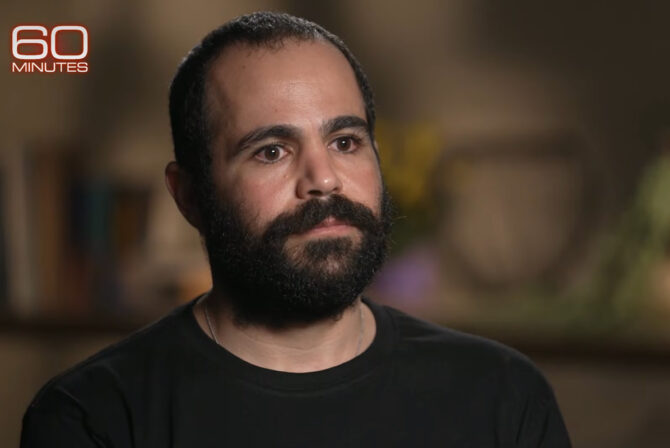A few weeks ago, I was at a Friday night Shabbat service with my family. My 2-and-a-half-year-old looked up at me from his seat and asked, “Mommy, who’s singin’?”
“That’s the cantor,” I whispered back.
Of course, he had to follow up my answer with a question: “Why?” (Did I mention he’s 2-and-a-half?) I leaned over and answered, “Because she’s singing the prayers.”
The woman sitting on the other side of him sighed loudly. And of course, my son inevitably asked again: “Why?”
I put my hands on both sides of his face and leaned as close as I could to him. “We have to be quiet during the service,” I whispered, my nose touching his.
“Why?” he whispered back.
“Because other people are trying to sing along with the cantor,” I whispered.
This was followed by a sigh so loud that it drowned out his little “Why?”
Defeated, I picked up my son and his bag of snacks and toys and took him out of the sanctuary. One minute later, my husband and our 4-and-a-half-year-old joined us. We were just five minutes into the service and, once again, we were on the other side of a closed door.
My Judaism — which had been a source of meaning in my life, as well as inspiration for my art — is now a burden. It happened gradually, but it began after the birth of my children.
When my daughter was born, I would wrap her in the baby sling and bring her to Shabbat morning services. It was a truly wonderful feeling to have my baby girl sleeping on my chest while the songs and prayers washed over us. Of course, she wouldn’t sleep through the whole service. When she woke, I would find a dark corner in the synagogue and feed her. But it was hard to keep her quiet if we returned to the service, so we would wander the halls or visit the kids’ services.
Our routine slowly changed so we would attend the morning service in the sanctuary, then go to the kids’ services when they began. She loved the main service and even took some of her first steps in the aisle of the sanctuary, but it’s hard to keep a toddler silent and occupied. As I followed her around the room to make sure she didn’t disturb others, I realized that I had gone from actually praying to mindlessly singing along to not even knowing where we were in the service.
Before long, we had a second child, and it was just too hard to keep two kids quiet. Since I wasn’t able to pray anyway, there was no incentive to try. Why make the effort to get everyone out of the house in time if we would just end up sitting in the hallway outside the sanctuary?
So the kids’ services replaced the main service for our entire family. And it was okay — we had a simplified service with many of the same songs as the regular service. The kids really loved it, and I loved that they loved it. I loved that they recreated services at home, pretending to be the rabbi and cantor.
But I couldn’t get rid of that nagging feeling that my son was missing out on something. He didn’t have those first years of feeling at home in the sanctuary; he didn’t take his first steps in the aisle. He really wasn’t a part of the larger community — and I realized that none of us are anymore. What had happened to those spiritual moments I used to have? I missed the songs, the communal prayer, the ability to close my eyes for the Shema without wondering if both kids would still be in the room when I opened them.
When we made the kids’ service our family’s “main” service, I began leaving my tallit at home. With all the snacks and diapers we needed to leave the house, it was just one more thing to carry and, as much as I like a good dinosaur song, it’s not something I need to put prayer shawl on for.
One Shabbat morning, however, we ended up in the service for older children. The person leading it paused before the Shema to talk about the custom of gathering the fringes — the tzizit — from the four corners of our tallitot. My breath caught in my throat as I realized I had completely forgotten about this tradition that I had once performed daily.
Other practices are slipping away, too. Without the prayer and feeling of community I once loved, Judaism is losing meaning for me. Before having kids, I would never spend money on Shabbat. But now, I don’t always plan ahead so if we’re away from home, I find myself buying lunch or filling up the car. And if someone texts me on Shabbat, it’s less likely that I’ll wait until sundown to respond.
I wish I knew how to solve the problem. Our synagogue has tried many things — first, they put a bookcase with kids’ books in the front of the sanctuary to show that children were welcome. But when kids sat and used the books and made some noise, the bookcase was moved to the back of the sanctuary, where it’s now mostly unused.
Then, there was the monthly family Shabbat in the sanctuary. Fidget bags were provided — but, again, kids in the sanctuary are not silent. It’s easy to say that kids are welcome, but until everyone can accept that those kids will make some noise during the three-hour service, they’re not really.
So, In the meantime, I channel my feelings into my art. I recently made a piece, “Hanging by a Thread,” which shows how my connection to Judaism is eroding. The piece takes the shape of a tallit; the embroidered lines start out like stripes on a traditional tallit but are broken and fraying as they get further from the top. The tallit itself is also coming undone, with large tears. The knots on the tzitzit are untying — and a tiny figure at the bottom clutches onto the tzitzit, trying to hold on to what’s left of her Judaism.
That figure is me. I am still holding on. I see what had been meaningful about Judaism slipping away. I’m mourning that loss, but I’m hoping that we can discover new ways to make Judaism meaningful for all of us, together, as a family.








